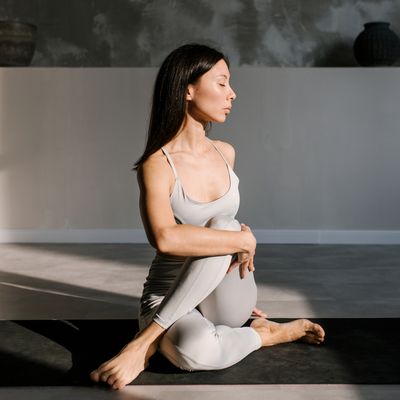
What You Need To Know About Yoga Nidra
What exactly is yoga nidra?
Often referred to as yogic sleep, yoga nidra is a simple but extremely effective relaxation technique. In fact, one hour of yoga nidra is said to be as restful as four hours’ sleep, making it perfect for when you’re feeling below par. However, it’s quite different from your average yoga class, says Alexandra Baldi, founder of Compass Chelsea. “During yoga nidra, your body is completely still and in a perpetual state of relaxation, whereas in yoga you are constantly connecting the mind to the body through breath and movement. At the same time, it differs from meditation, which requires more effort. Meditation helps train the mind to have a focus, whether that be an object or mantra, whereas yoga nidra supports deep rest and encourages the mind to wander without a focus. It’s a process of moving inwards and a passive practice of awareness.”
How does it work?
You know that moment, just before you’re about to fall asleep? You’re aware of your body, heavy and relaxed, and all your worries have shifted to the corner of your mind. You may have slightly odd, dreamlike thoughts while still being mostly aware of your surroundings. “This is exactly how you should feel when practising yoga nidra,” says Alexandra. Lisa Hood, yoga and ritual space holder, adds, “This form of yogic sleep allows you to slip in between the states of wakefulness and sleep, which in turn allows your body to fully let go of any tension. It’s very different to a physical yoga practice as there’s no movement. You simply need to lie down, get comfy and listen to your teacher, who will guide you through the session.”
So, what happens in a class?
Forget traditional yoga poses such as downward facing dogs and sun salutations. “The best way to describe yoga nidra is saying it’s like savasana,” says Alexandra. “The difference is that while in a traditional yoga class, you may only be in savasana for a few minutes, in a yoga nidra class you’ll be holding it for the full practice, which can last anywhere from 30 to 60 minutes. This may sound like a long time, but this is the time it takes for your body to enter a parasympathetic state, in which the heart rate and breath slow down, which is the main goal of yoga nidra,” she says. The teacher will welcome you to lie down and get comfortable, starting the session with an intention, before working through various sequences of words and breath patterns, which have been designed to relax the body and mind and awaken your subconscious and unconscious mind. “Sessions conclude with you slowly being guided back into your body using your breath and very soft, intuitive movement,” Lisa adds.
How do you feel afterwards?
“When you have finished a class, your body will be in a deeply relaxed state,” says Lisa. “You will feel restored, healed and gloriously rested.” The only negative is that you may feel a little chilly, as your body temperature naturally drops when you are relaxed. “For this reason, make sure you have a blanket and some warm socks to hand when practicing yoga nidra, especially if you are at home and doing a virtual session,” says Lisa. A bolster, which you prop under your knees, can also be handy if you suffer with lower back pain.
Does it matter if you fall asleep?
Yoga nidra may be a form of sleep meditation, but that doesn’t mean it’s the same thing as sleep, and the experts say you should stay awake, if you can. “There is controversy in the yoga world over whether it’s okay to fall asleep during yoga nidra. In my opinion, it’s a hard no. Once you fall asleep, you’re no longer in yoga nidra, and may not get as many of the benefits. The longer you stay in the space, the more easily you can reap the restorative benefits.” If you’ve tried yoga nidra and struggle to stay awake, try practicing during the day, when you’re more alert and able to better focus your energy.
Aside from feeling relaxed, are there any other benefits?
“Yoga nidra can really benefit people who struggle with anxiety, insomnia and sleep deprivation,” says Lisa. “And the best thing is there’s no right or wrong way to do it,” adds Alexandra. “At first, some people may struggle to relax, especially if this form of relaxation technique is new to them. They may fidget and seem restless, but over time, they soon start to let that go.
How often should you do it?
There’s no right or wrong, says Lisa. “You can practice yoga nidra as often as you like – if you feel you need to do it daily, that’s great. However, as your life ebbs and flows you may find yourself practicing more in times of stress or to help with sleep patterns. Go with how you feel and what your body wants,” she advises.
How can you get started?
Do some research on local yoga studios near you and see if they offer yoga nidra. “Just make sure the class specifically says yoga nidra, not just guided meditation,” says Alexandra. “It can also help to try various classes to see if a particular teacher resonates with you.” It’s also possible to do yoga nidra virtually – there are dozens of classes available on YouTube as well as on-demand yoga platforms.
The bottom line?
As a culture, we’re always connected, often stressed and our nervous systems are constantly in a fight or flight, sympathetic state. Yoga nidra is an effective way to access the magic ‘rest and digest’ state, which is where healing happens. Less physically taxing than yoga and mentally easier than meditation with arguably even more benefits, yoga nidra could be just what the doctor ordered.
For more information visit LAHoodYoga.com and CompassChelsea.com
DISCLAIMER: Features published by SheerLuxe are not intended to treat, diagnose, cure or prevent any disease. Always seek the advice of your GP or another qualified healthcare provider for any questions you have regarding a medical condition, and before undertaking any diet, exercise or other health-related programme.
DISCLAIMER: We endeavour to always credit the correct original source of every image we use. If you think a credit may be incorrect, please contact us at info@sheerluxe.com.























